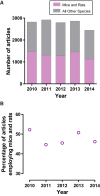Problems and Progress regarding Sex Bias and Omission in Neuroscience Research
- PMID: 29134192
- PMCID: PMC5677705
- DOI: 10.1523/ENEURO.0278-17.2017
Problems and Progress regarding Sex Bias and Omission in Neuroscience Research
Abstract
Neuroscience research has historically ignored female animals. This neglect comes in two general forms. The first is sex bias, defined as favoring one sex over another; in this case, male over female. The second is sex omission, which is the lack of reporting sex. The recognition of this phenomenon has generated fierce debate across the sciences. Here we test whether sex bias and omission are still present in the neuroscience literature, whether studies employing both males and females neglect sex as an experimental variable, and whether sex bias and omission differs between animal models and journals. To accomplish this, we analyzed the largest-ever number of neuroscience articles for sex bias and omission: 6636 articles using mice or rats in 6 journals published from 2010 to 2014. Sex omission is declining, as increasing numbers of articles report sex. Sex bias remains present, as increasing numbers of articles report the sole use of males. Articles using both males and females are also increasing, but few report assessing sex as an experimental variable. Sex bias and omission varies substantially by animal model and journal. These findings are essential for understanding the complex status of sex bias and omission in neuroscience research and may inform effective decisions regarding policy action.
Keywords: Animal models; journals; neuroscience; sex bias; sex omission.
Conflict of interest statement
Authors report no conflict of interest.
Figures






References
-
- Beach FA (1950) The snark was a boojum. Am Psychol 115–124. 10.1037/h0056510 - DOI
MeSH terms
Grants and funding
LinkOut - more resources
Full Text Sources
Other Literature Sources
